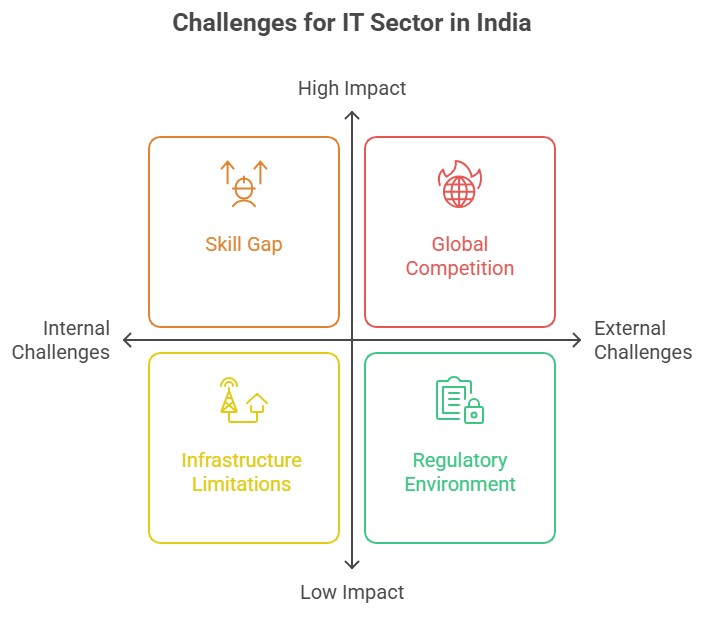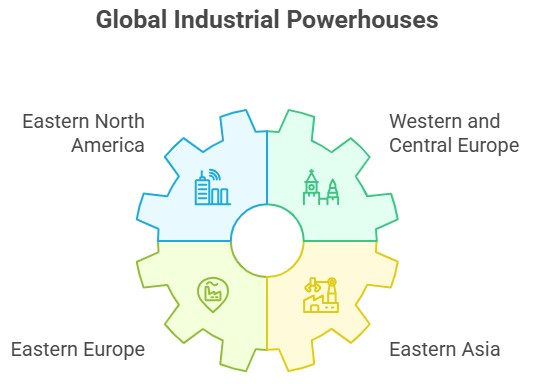Industrial regions play a crucial role in shaping the economic landscape of the world. These regions are characterized by concentrations of industries and manufacturing activities, typically driven by factors such as access to resources, favorable geographical conditions, skilled labor pools, infrastructure, and market proximity. Industrial regions are dynamic hubs of economic activity, fostering innovation, productivity, and regional development.
Factors Affecting Location of Industries

Industrial Regions of the World
- Industrial regions emerge when a number of industries locate close to each other and share the benefits of their closeness.
- Factors Influencing Industrial Region Location:
- Proximity to Sea Ports
- Availability of Coal Fields
- Temperate Climate Zones
Major Industrial Regions Worldwide
- Eastern North America
- Western and Central Europe
- Eastern Europe
- Eastern Asia
Industrial Regions in India
- Mumbai-Pune Cluster
- Bangalore-Tamil Nadu Region
- Hugli Region
- Ahmedabad-Baroda Region
- Chottanagpur Industrial Belt
- Vishakhapatnam-Guntur Belt
- Gurgaon-Delhi-Meerut Region
- Kollam-Thiruvanathapuram Industrial Cluster
Distribution Of Major Industries
- The world’s major industries are the iron and steel industry, the textile industry and the information technology industry.
- The iron and steel and textile industry are the older industries while information technology is an emerging industry.
- The countries in which iron and steel industry is located are Germany, USA, China, Japan and Russia.
- Textile industry is concentrated in India, Hong Kong, South Korea, Japan and Taiwan.
- The major hubs of Information technology industry are the Silicon valley of Central California and the Bangalore region of India.
Importance of IT Sector for Industrial Regions in India
|
FY 2019-20
|
$ 150 Billion
|
|
FY 2020-21
|
$ 151 Billion
|
|
FY 2021-22
|
$ 178 Billion
|
- As per the data provided by National Association of Software and Service Companies (NASSCOM), the total amount of IT export from the country during last three years is as below:
- As per National Association of Software and Services Companies (NASSCOM), Indian Information Technology (IT) Industry directly employs around 51 lakh persons in FY 2021-22, most of which are IT skilled.
- In addition, with increasing digitalization under the Digital India program in the last 7 years, other economic sectors have created large opportunities for digitally enabled jobs.
- As per report by Ministry of Electronics & IT on “India’s trillion-dollar digital opportunity”, India is poised to be a trillion dollar digital economy and could support 60 to 65 million digitally enabled jobs by 2025-26.
- As per NASSCOM, the projected requirement of manpower by Indian IT industry itself by the year 2026 would be around 95 lakhs, for India to maintain the growth momentum in IT sector and also of which 55 lakh will be digitally skilled across key digital technologies such as cloud computing, AI, big data analytics and IoT etc.
Government Initiatives to Boost IT Exports in Industrial Regions
- Software Technology Parks of India (STP) Scheme:
- STPI implements the 100% export-oriented STP Scheme for software development and export.
- Registered IT/ITeS units under STPI have shown consistent YoY growth, reaching $80.3 billion in FY 2021-22.
- Special Economic Zones (SEZs):
- SEZ Act, 2005, supports the promotion of goods and services export, job creation, and economic activities.
- SEZs facilitate a favorable environment for IT companies, attracting investments and boosting exports.
- Future Skills PRIME Program:
- MeitY collaborates with IT/ITeS Sector Skills Council-NASSCOM for reskilling/upskilling of IT professionals.
- The program focuses on emerging technologies such as AI, Big Data Analytics, Cloud Computing, and Cybersecurity.
- Domain-Specific Centers of Entrepreneurship:
- Government establishes centers across India to nurture innovation, startups, and private investments.
- These centers cater to new and emerging technologies, fostering a robust ecosystem for growth and employment.
- National Policy on Software Products-2019:
- The policy aims to position India as a global software product hub through innovation and IP protection.
- It encourages technology startups, specialized skill development, and the overall development of the software product sector.
- Next Generation Incubation Scheme (NGIS):
- NGIS supports the software product ecosystem and aligns with the National Policy on Software Products.
- Its objective is to enhance competitiveness, create employment opportunities, and foster continued growth.
- Market Outreach Initiatives and Market Development:
- Initiatives provide support to Indian IT/ITeS SMEs in generating market linkages in the USA, UK, Nordics, and Africa.
- These efforts aim to enhance export opportunities and expand overseas market presence for the IT sector.
Challenges for IT Sector in India
- Skill Gap: There is a shortage of skilled professionals with specialized IT skills, leading to a skill gap in the industry.
- Infrastructure Limitations: Inadequate and unreliable IT infrastructure, including power supply and internet connectivity, pose challenges for the smooth functioning of the IT sector.
- Data Security and Privacy Concerns: The increasing prevalence of cyber threats and data breaches raises concerns about data security and privacy, impacting the trust of clients and customers.
- Global Competition: The IT sector faces intense competition from other countries with lower labor costs and advanced technological capabilities, making it challenging to retain and attract clients.
- Regulatory Environment: Complex and evolving regulations related to data protection, intellectual property rights, and taxation can create compliance challenges for IT companies.
- Talent Retention and Attrition: High attrition rates and the challenge of retaining skilled employees pose significant challenges in maintaining stability and continuity in projects.
- Changing Technology Landscape: Rapid advancements in technology require continuous upskilling and adaptation, which can be a challenge for both individuals and organizations.
- Digital Divide: Disparities in access to technology and digital literacy create a digital divide, limiting the sector's growth potential in certain regions or sections of society.

Way Forward For Industrial Regions of the World
- Foster Innovation and Research: Promote investment in research and development to drive innovation and technological advancements in industrial regions.
- Enhance Infrastructure: Improve transportation networks, logistics systems, and connectivity to facilitate the efficient movement of goods and services within and outside industrial regions.
- Sustainable Development: Encourage sustainable practices and technologies to minimize environmental impacts and promote eco-friendly industrialization.
- Collaboration and Networking: Foster collaboration between industries, academia, and government bodies to facilitate knowledge sharing, skill development, and industry-academia partnerships.
Way Forward For Industrial Regions in India
- Skill Development: Focus on skill development initiatives to create a skilled workforce capable of meeting the evolving needs of industries in areas like emerging technologies, digitalization, and automation.
- Ease of Doing Business: Simplify bureaucratic processes, reduce regulatory burdens, and provide a conducive business environment to attract investments and promote entrepreneurship.
- Infrastructure Development: Invest in robust infrastructure, including transportation, power, and digital connectivity, to support industrial growth and enhance the competitiveness of Indian industrial regions.
- Regional Imbalance: Address regional imbalances by promoting industrialization in underdeveloped regions, ensuring inclusive growth, and reducing inter-regional disparities.
- Sustainable Industrialization: Promote sustainable practices, renewable energy adoption, waste management, and environmental regulations to ensure sustainable industrial growth.
- International Cooperation: Strengthen international collaborations and partnerships to attract foreign investments, facilitate technology transfer, and promote export-oriented industries.
- Policy Support: Continuously review and refine industrial policies, addressing challenges, and aligning with global trends to create a favorable business environment for industrial development.















